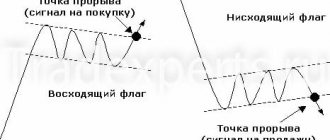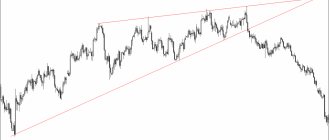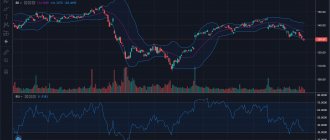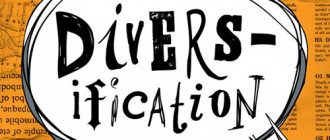08/19/2021 Section: How to invest on your own
Difficulty level:
- 48
- 12358
- +36
- -10
This material explains that diversification is not a tool for downside protection, but rather a tool for increasing the certainty of an investment outcome. Introduces the concept of a diversified portfolio and provides diversification tips for investors.
A lot of material has been written about the concept of diversification. Various authors are trying to reveal and convey to readers the meaning of diversification. Basically, the essence of all these studies comes down to a dictionary definition:
“Diversification is the distribution of invested monetary capital between various investment objects in order to reduce the risk of possible capital losses.”
We decided to go a little further and look at the concept of diversification a little differently.
What is the connection between a large chain grocery store and investing in the stock market? At first glance, there is no connection, what could there be in common? But it turns out that both there and there are actively using diversification.
It's no secret that in large stores there is a certain level of theft of goods, which affects the store's profit. If in a store one buyer bought something for 100 rubles and another “buyer” stole goods worth 100 rubles from the store, then in order to make a profit, the store will be forced to raise the price of the goods to 200 rubles. In order to avoid such a situation, chain stores first of all strive to increase the number of customers. After all, if a thousand customers visited the store, then they will spend 100 thousand rubles, the level of theft in absolute numbers may also increase, but here the “law of large numbers” comes into play. Above a certain percentage of buyers, the theft rate does not change.
That is, by increasing the number of customers, chain stores do not protect themselves from theft, but increase the certainty of receiving a given level of losses as a percentage of revenue. For them, this is diversification. By the way, when you see that someone is stealing in a store, you must understand that this someone is stealing from you, because the store, knowing about the constant percentage of losses, includes in the markup not only the profit for itself, but also these losses.
Diversification is the investor's only free lunch
Diversification is investing in different assets to reduce risk.
For example, if you invest only in shares of Gazprom, Rosneft and Lukoil, then it can hardly be called diversification, because all three companies are Russian and belong to the oil and gas industry. If one day natural resources depreciate for some reason, you will lose most of your savings. It is important to allocate assets across different classes, countries and industries. Nobel Prize winner in economics and author of modern portfolio theory Harry Markowitz proved back in the middle of the last century that diversification is the only “free lunch” for an investor. This means that by combining different assets, an investor can achieve greater returns for a given risk.
Investment risk is the probability of partial or complete loss of funds invested in financial assets.
According to modern portfolio theory, to measure the investment risk of a portfolio, the calculation of volatility and correlation of daily asset returns on historical data is used. But we will not delve so deeply into mathematical calculations in this article. It is much more important to figure out how to ensure the best diversification of a long-term investment portfolio with simple actions.
Distribute investments across economic sectors
To ensure that your portfolio is not dependent on the situation in one specific sector, invest in companies from different sectors. When some industries are in decline, others are growing, as the current coronavirus crisis clearly demonstrates. For example, aviation and oil and gas companies suffered due to the pandemic, but drug manufacturers and online retailers, on the contrary, grew.
Conventionally, industries can be divided into cyclical and protective. The first include areas that are highly dependent on the state of the economy - oil and coal production, heavy industry, and the banking sector. Shares of such companies tend to be highly volatile, which increases investment risks. Protective industries include healthcare, consumer goods, and telecommunications. Demand for these services is usually stable, which means that company shares are less subject to fluctuations.
It is not necessary to invest in all sectors of the economy at once. Select the industries that are most interesting to you or in which you have the best knowledge.
What types of diversification are there?
There are at least four types of diversification:
Diversification by asset class
Your investment portfolio should include not only stocks, but also bonds and commodities.
Each asset class is unique: stocks, while highly volatile, allow investors to benefit from economic growth, provide long-term capital growth, and provide effective long-term inflation protection.
Bonds and other debt instruments can provide a current stream of income, but cannot protect against unexpected price increases.
Assets that protect investors from inflation in conditions of both moderate and high price increases include:
- government bonds indexed by inflation (FXTP, FXIP),
- real estate,
- commodities or commodities such as gold (FXGD).
Conclusion:
The portfolio should include different asset classes - stocks, bonds, commodities. This will allow the investor to benefit from the beneficial properties of each of them and minimize the risks.
Diversification by country
The key argument in favor of country diversification is the unevenness and cyclical nature of economic processes. Those countries that are currently developing more actively than others may lose their primacy in a few years. You can see how leaders change approximately every 15 years by studying the dynamics of the American market (FXUS) and developed markets without the United States (FXDM). Here is their historical comparison:
Dynamics of MSCI USA Index, MSCI World ex US Index, 1970–2021
To understand how countries' shares in the global economy have changed over a longer horizon, let's look at charts from the Credit Suisse review. On the left is the distribution of each country's share in the global economy in 1899, on the right - in 2022. Over 140 years, the situation has changed dramatically.
Shares of countries in the global economy (1899 and 2022)
Conclusion:
Investors, as much as they might like, cannot predict the future, so it is important to use broad country diversification.
Diversification by industry
Industry asset allocation is also important for a long-term investor. The predominance of one sector in the portfolio imposes additional risks. For example, if an investor invests only in companies in the gaming industry (FXES), he is exposing himself to the specific risks of that industry. They can be avoided by, say, adding broad market stocks.
The industry breakdown of FinEx ETFs can be found on the main information pages for each fund.
Nowadays, the IT sector occupies a significant share of global distribution, but this does not mean that it will always remain dominant. If in 1900 you had invested all your money in US railway transport (the most promising industry at that time), then by 2022 you would have lost a significant part of your savings.
Sectoral distribution of the US and UK economies in 1900 and 2022
Conclusion:
The distribution by industry is as variable as the economic development of countries. Betting on only one sector is irrational.
Diversification by currency
Investors can improve diversification by holding securities denominated in multiple currencies, each of which behaves independently of share price. Different markets and currencies may react to market cycles and world events differently at different times and to different degrees.
During periods of weakening of the US dollar, holding a portfolio of assets in other currencies can protect the investor from the loss of purchasing power of the dollar and increase investment returns.
US Dollar Index and Its Market Cycles, 1980–2020
To explain the benefits of currency diversification, let's look at an example given by JP Morgan analysts. The US dollar index is down 7% in 2022, with the dollar weakening against the euro by nearly 15%. This served as a driver for the growth of the value of companies outside the United States. For 2022, the MSCI All World ex-US Index outperformed the S&P 500 by nearly 500 basis points in dollar terms.
Conclusion:
if the assets within the fund are denominated in different currencies, you additionally protect yourself from the risk of devaluation.
Money collision
The result of a 100% diversified portfolio characterizes the average result that market participants could have without taking into account transaction costs, the use of shorts, leverage, and attempts to speculate. However, statistics show that this result is lost by 80% of participants due to transaction costs and the amount of money in the portfolio. But if the market has risen, money worsens the average outcome of participants. If the market has fallen, they improve (the result of money is always zero). Since, according to statistics, the stock market grows over the long term, money ultimately leads to losses. Yes, you can make a mistake in assessing the potential of a particular stock, but not in the case of money. Their potential is always zero, and taking into account inflation it is negative. Therefore, we adhere to the principle of full investment. According to our estimates, the share of money in the portfolios of market participants averages 7-10%, although for speculators it can reach 50% or more.
How correlation can help you understand the principle of diversification
Correlation
— a statistical indicator of the relationship between changes in the dynamics of two assets. The closer the correlation is to one, the more co-directional the assets behave. And vice versa: the closer the correlation is to minus one, the more divergent they are.
The lower the correlation between assets, the better for the investment portfolio. In our quarterly risk monitor, we publish correlation matrices for all FinEx ETFs.
Correlation of FinEx funds for three years in rubles
Note: DR - money market, BT - commodities
Source: Bloomberg, FinEx calculations (June 2022 - June 2021)
Selecting funds for a portfolio based on historical correlation data can be difficult. It is also important to remember that past performance cannot predict the future. However, there are universal recommendations with which you can avoid severe portfolio drawdowns and take advantage of all the benefits of diversification:
- When diversifying your portfolio across asset classes, use ETFs.
With just one fund share, you can diversify your investments by sector (any broad country ETF), by country and by currency (FXDM, FXWO). When you buy a bond ETF, you are investing in dozens of bond issues at once. Gold ETF (FXGD) is simply the most convenient way to invest in the precious metal. - Don't forget about country diversification.
You shouldn’t get carried away by one market, even if you really like it. Make sure your portfolio includes both developed and emerging markets. If it is difficult to decide on the proportions of each country, use our constructor or take a closer look at the FXWO/FXRW global funds (they include both developed and developing economies). - Use funds whose assets are denominated in different currencies.
This will help maintain currency diversification and protect your portfolio from geopolitical and macroeconomic risks, to which exchange rates react sharply.
Advantages and disadvantages of the method
Let's consider the advantages of production diversification:
- Possibility of suspending work in an irrelevant industry.
- Reducing dependence on a single product or market.
- Expansion of the sales market.
- Increased creditworthiness.
- Redistribution of risks.
The considered advantages are achieved through the following tools:
- Multipurpose use of available resources.
- Creation of a profitable sales network.
- Versatile employee training.
However, the procedure is also not without its drawbacks:
- The need to introduce new technologies.
- The need for resources for change, the need for funding.
It is important to diversify production correctly. Otherwise, investments in changes will not pay off.










